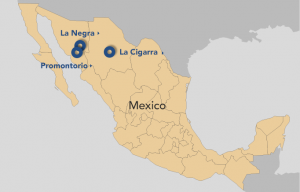![]() Kootenay Silver {TSX.V: KTN}
Kootenay Silver {TSX.V: KTN}
Announced assay results of the first six holes drilled on the Columba high-grade silver vein system in Chihuahua State, Mexico.
Drilling is ongoing with 11 holes completed to date of a planned first phase 25 to 30-hole program.
.
.
.

.
.
.
KOOTENAY ANNOUNCES DRILL RESULTS CONFIRMING SHALLOW, HIGH GRADE SILVER MINERALIsATION ON COLUMBA SILVER PROJECT, MEXICO
Highlights Include 2.0 Meters of 517.87 gpt Silver with 1.0 Meter of 775 gpt Silver
.
Kootenay Silver Inc. (TSXV: KTN) (the “Company” or “Kootenay”) is pleased to announce assay results of the Company’s first six holes drilled on the Columba high-grade silver vein system in Chihuahua State, Mexico. Drilling is ongoing with 11 holes completed to date of a planned first phase 25 to 30-hole program.
m
Kootenay President and CEO James McDonald states, “We are off to a successful start with our first six holes drilled at Columba verifying the F Vein is where expected and carrying high grade silver mineralisation as high as 775 gpt silver. Drilling and detailed surface mapping confirms our belief the system is large and strong giving us added confidence in the chances of discovering a high-grade silver deposit.”
.
Drilling Discussion and Highlights:
The first dozen holes of the program are targeting the F vein, which was briefly mined during the 1910 era and again in the late 1950’s to early 1960’s. Drilling is being carried out by Kootenay to verify vein widths, grades and location. Results thus far have confirmed good widths of quartz, quartz-calcite vein and vein breccia and stockwork have been encountered in 5 of 6 holes with some holes hitting unexpected hanging wall veining. Drilled widths are excellent and vary from 4.8 to 16.5 meters on the F vein and from 1.17 to 1.5 meters on previously unknown hanging wall veins in two of the holes reported here (CDH 19-002 and 006).
.
Holes CDH-001 to 003 were drilled peripheral to a 90-meter deep shaft, an area which was mined in the 1910 era. The holes are shallow and intercepted grades comparable to historical samples reported in nearby tunnels and old stopes. To view drill hole location click on following links to a plan map and longitudinal map.
.
CDH 19-001:
- 390 gpt silver over 1 meter within a much wider 16.5 meters of 93 gpt silver including 9.42 meters of 140. 68 gpt silver.
- The higher-grade interval is consistent with grades and widths reported in historic data at these shallow depths and is very encouraging regarding the high-grade potential.
CDH 19-002:
- 332 gpt silver and 0.554 gpt gold over 0.73 meters and 328 gpt silver over 1 meters both within a much wider 14 meters of 104 gpt silver and 3.73 meters of 213 gpt silver with 0.311 gpt gold.
- Hole 002 also hit an unknown hanging wall vein grading 111 gpt silver over 1.17 meters indicating potential for blind discoveries in addition to the numerous veins exposed at surface.
CDH 19-003:
- Hit a faulted section of vein and returned 85 gpt silver over 5 meters with a high of 147 gpt silver over 1 meter.
CDH 19-004: hit a fault zone and missed the vein due to probable displacement on the fault.
Holes CDH-005 and 006 were drilled west of the deeper 200-meter-deep shaft around old mine workings developed in the early 1900’s and mined then and in the late 1950’s to early 1960’s. These holes and old mine workings are also on the F vein.
CDH 19-005:
- 775 gpt silver over 1.15 meters within 2 meters of 518 gpt silver and 230 gpt silver over 4.83 meters.
- These results confirm high grades in the system that are in line with historically reported numbers.
CDH 19 006:
- 287 gpt silver over 1.45 meters within 133 gpt silver over 10.45 meters before entering into a mine stope over 3 meters wide; presumably where historic mining removed the high grades, historically reported in the F vein.
- Hole 006 also hit two hanging wall veins with 235 gpt silver over 1.5 meters and 267 gpt silver over 0.87 meters, which again indicate potential for blind discoveries during the program. More drilling is required to understand these hanging wall veins and their importance.
.
The first six holes have confirmed the F vein strike and dip and that it carries high-grade silver as evidenced by assays over 300 gpt silver to a high of 775 gpt silver. The total width of the vein was not reported in historic records with only the highest grades from 1 to 4-meter widths shown on old maps. Thus, the potential width of the F vein at depth was unknown until now.
.
Drilling thus far has tested approximately 450 meters of strike in broad spaced fences of holes from depths as shallow as 20 meters to as deep as 150 meters with 5 of 6 holes intercepting the F vein.
.
Having established good widths and grades in the F vein in historically worked areas, drilling will now test the F vein where it is undisturbed and untested by modern or historic work. The program will then move systematically from the F vein to the I vein, E vein, J vein, O vein and so on.
/
The F vein consists of a primary vein with significant vein, vein breccia and stockwork on its hang wall side. The vein thus far displays classic high-level epithermal textures with evidence of multiple pulses of mineralisation in the multi-banded, brecciated and re silicified textures variously cross cutting one another.














